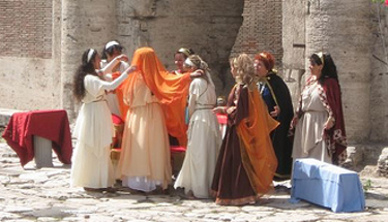 SONG OF THE NILE, begins with the wedding of my heroine, Cleopatra Selene, to the man the emperor has chosen for her. Like any bride, she is nervous and excited about her future. Her groom is the newly made King of Mauretania, and she is about to become a queen of a new world. But she’s also only fourteen years old, inexperienced, and vulnerable.
SONG OF THE NILE, begins with the wedding of my heroine, Cleopatra Selene, to the man the emperor has chosen for her. Like any bride, she is nervous and excited about her future. Her groom is the newly made King of Mauretania, and she is about to become a queen of a new world. But she’s also only fourteen years old, inexperienced, and vulnerable.
Selene was a Hellenized Egyptian royal princess who was raised in Rome, and Roman girls married young. This was especially true if they were noble or royal because their value to their husbands was often to be found in their ability to bear children and continue the line. Consequently, a girl was marriageable at the age of twelve.
This strikes us as obscenely young and entirely foreign–after all, we live much longer lives than the ancients and have some very different points of view when it comes to marriage.
But weddings in Rome weren’t altogether different than weddings today. In fact, if an ancient Roman girl were to accidentally stumble upon a modern wedding ceremony, chances are good that she’d recognize it for exactly what it was. This is because many of our modern wedding traditions can be traced directly to the ancients.
For example, the tradition of a wedding ring started because the Romans believed that the nerve of the fourth finger of the left hand ran directly to the heart. A ring was often a betrothal gift. Roman brides also wore veils, though theirs were dyed a bright saffron color and topped with a wreath of flowers. Wedding cake is also nothing new. The Roman version was made of spelt or barley or wheat. Sometimes it was a loaf broken over the bride’s head. Then the bride and the groom would each take a bite to symbolize that they have now eaten together and should stay together. (In modern times, the bride and the groom feed each other the cake and sometimes smoosh it in each other’s faces. You tell me which is the more romantic take on the tradition!)
After the vows were spoken and the contracts were signed, there was a celebration–usually a wedding breakfast–during which guests drank, did their version of the chicken dance, then escorted the bride and groom out to a host of bawdy jokes. That part of a modern wedding where the guests all throw rice or blow bubbles at the bride and groom? The ancients would throw a sweet mixture of fruit and nuts to symbolize their wish for the couple’s fertility and prosperity. (Imagine being pelted with trail mix on your happy day!)
Finally, a Roman bride was always carried over the threshold…albeit, not by the groom. In ancient times, she would ritually adorn the doorway to her husband’s house and then slaves, freedmen or wedding attendants would carry her inside.
Finally, there was no requirement that a marriage be consummated, but it was certainly expected!


Very interesting! I never knew many of our modern day traditions was founded in the ancient times. Not surprising though…
Thanks for sharing!
Isn’t that fun, Carole?
It is! It’s pretty nefty on how things we see is so connected with the past. Thats one reason why I love history.
That’s so cool! I knew that the wedding ring was an ancient tradition but I had no clue about things like the veils and the cake!